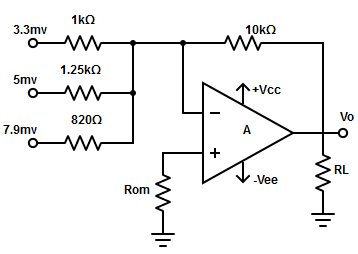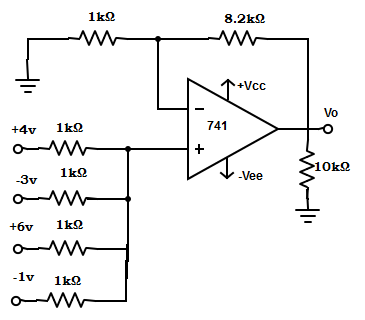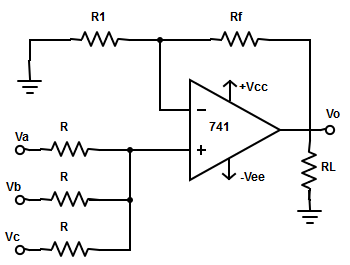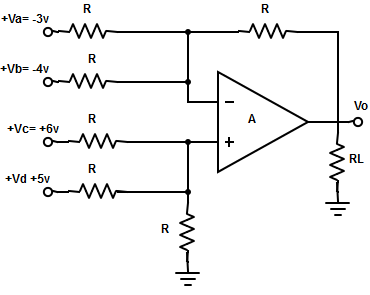21. An amplifier in which the output voltage is equal to an average input voltage?
A. Summing amplifier
B. Weighting amplifier
C. Scaling amplifier
D. Averaging amplifier
22. Find out the gain value by which each input of the averaging amplifier is amplified? ( Assume there are four inputs)
A. 0.5
B. 0.25
C. 1
D. 2
23. 3v, 5v, and 7v are the three input voltages applied to the inverting input terminal of the averaging amplifier. Determine the output voltage?
A. -5v
B. -10v
C. -15v
D. -20v
24. The following circuit represents an inverting scaling amplifier. Compute the value of RoM and VO?

A. VO = -0.985v ; RoM = 111.11Ω
B. VO = -2.567v ; RoM = 447.89Ω
C. VO = -1.569v ; RoM = 212.33Ω
D. VO = -1.036v ; RoM = 320.56Ω
25. Which type of amplifier has output voltage equal to the average of all input voltages?
A. Inverting averaging amplifier
B. Non-inverting averaging amplifier
C. Non-inverting summing amplifier
D. Inverting scaling amplifier
26. Expression for output voltage of non-inverting summing amplifier with five input voltage?
A. Vo = 5×( Va + Vb+ Vc+ Vd+ Ve)
B. Vo = [1+( Rf/R1)]× ( Va + Vb+ Vc+ Vd+ Ve)
C. Vo = Va + Vb+ Vc+ Vd+ Ve
D. Vo = ( Va + Vb+ Vc+ Vd+ Ve) /5
27. Find the value of V1 in the circuit shown below?

A. 4v
B. 2v
C. 3v
D. None of the mentioned
28. If the gain of a non-inverting averaging amplifier is one, determine the input voltages if the output voltage, if the output voltage is 3v?
A. V1 = 6v ,V2 = 3v and V3 = 2v
B. V1 = 9v ,V2 = 5v and V3 = -4v
C. V1 = 8v ,V2 = -6v and V3 = 1v
D. V1 = 7v ,V2 = 4v and V3 = -3v
29. In the circuit shown, supply voltage = ±15v, Va = +3v , Vb = -4v , Vc = +5v, R = R1 = 1kΩ and RF = 2kΩ. 741 op-amp has A = 2×105 and R1 = 10kΩ. Determine the output voltage internal resistance of the circuit?

A. Vo ≅3v , RiF = 6.67MΩ
B. Vo ≅3v , RiF = 7MΩ
C. Vo ≅3v , RiF = 9.2MΩ
D. Vo ≅3v , RiF = 3.5MΩ
30. Find the type of amplifier that cannot be constructed in differential configuration?
A. Summing amplifier
B. Scaling amplifier
C. Averaging amplifier
D. Subtractor
31. Calculate the output voltage, when a voltage of 12mv is applied to the non-inverting terminal and 7mv is applied to inverting terminal of a subtractor.
A. 19mv
B. 5mv
C. 1.7mv
D. 8.4mv
32. How many additional sources are connected to each input terminal to obtain an eight-input summing amplifier?
A. Six
B. Three
C. Four
D. Eight
33. Calculate the output voltage for the summing amplifier given below, where R = 2kΩ and RL = 10kΩ.

A. 4v
B. 18v
C. 8v
D. None of the mentioned
34. The output voltage of a summing amplifier is equal to (assume the sum of input voltage as Vn )
A. V (non-inverting terminal)+ Vn (inverting terminal)
B. Vn (non-inverting terminal)+ (-Vn (inverting terminal)
C. -Vn (non-inverting terminal)+ (-Vn (inverting terminal)
D. -Vn (non-inverting terminal)+ Vn (inverting terminal)
35. Strain gauge is an example of which device?
A. Transducer
B. Voltage follower
C. Integrator
D. Differentiator
36. An instrumentation system does not include
A. Transducer
B. Instrumentation amplifier
C. Automatic process controller
D. Tester
37. Transmission lines are used for
A. Output signal
B. Input signal
C. Signal transfer
D. All of the mentioned
37. The length of the transmission lines are
A. Longer than 10 meters
B. Shorter than 10 meters
C. Equals to 10 meters
D. None of the mentioned
38. Why output of the transducer is not directly connected to the indicator or display?
A. Low-level output is produced
B. High-level output is produced
C. No output is produced
D. Input is fed directly
39. What are the features of an instrumentation amplifier?
A. Low noise
B. High gain accuracy
C. Low thermal and time drift
D. All of the mentioned
40. What is the disadvantage of using LH0036 instrumentation op-amp?
A. Extremely stable
B. Relatively expensive
C. Accurate
D. All of the mentioned
Answer:b
LH0036 is a very precise special-purpose circuit in which most electrical parameters are minimized and performance is optimized. So, it is relatively expensive. [/bg_collapse]
